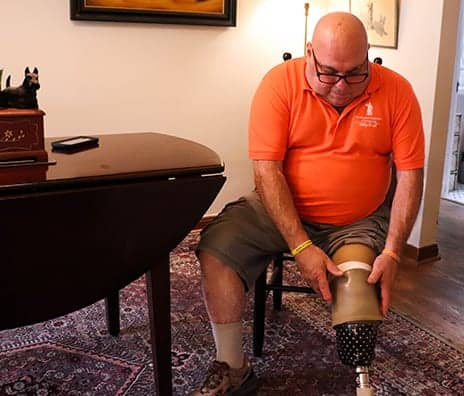
Robert Haas experienced debilitating pain following the amputation of his left leg that prevented him from using his prosthetic and required medication to manage. However, a surgery that reconnects severed nerves eliminated his pain and allowed him to adjust to life with an artificial limb. (Photo courtesy of The Ohio State University Wexner Medical Center)
Researchers suggest life-altering benefits may be possible as the result of targeted muscle reinnervation (TMR), a surgical procedure developed for advanced prosthetics to help prevent or reduce phantom limb and stump pain in amputees.
In a recent issue of Plastic and Reconstructive Surgery, Dr Ian Valerio, division chief of Burn, Wound and Trauma in Ohio State’s Department of Plastic and Reconstructive Surgery, and Dr J. Byers Bowen, a former resident who is now in private practice, describe how to perform this technique in below-the-knee amputees.
They also document the benefits of primary TMR for preventing pain, according to a media release from The Ohio State University Wexner Medical Center.
Over the course of three years, the surgeons performed 22 TMR surgeries on below-the-knee amputees, 18 primary and four secondary. None of the patients have developed symptomatic neuromas and only 13 percent of patients who received primary TMR reported having pain six months later.
“A significant amount of pain in amputees is caused by disorganized nerve endings, ie, symptomatic neuromas, in the residual limb. They form when nerves are severed and not addressed, thus they have nowhere to go,” Valerio says, in the release. “Attaching those cut nerve endings to motor nerves in a nearby muscle allows the body to re-establish its neural circuitry. This alleviates phantom and residual limb pain by giving those severed nerves somewhere to go and something to do.”
Valerio adds that patients who’ve had TMR significantly reduce or sometimes stop using narcotics and other nerve pain related medications, which can greatly improve their quality of life.
“TMR has been shown to reduce pain scores and multiple types of pain via a variety of validated pain surveys. These findings are the first to show that surgery can greatly reduce phantom and other types of limb pain directly,” Valerio comments.
Upper extremity amputees are better able to use and control their prosthetics in addition to their improved pain outcomes, according to Bowen.
“TMR allows for more individual muscle unit firings through the patient’s thoughts. It provides for better intuitive control, resulting in more refined functional movements and more degrees of motion by an advanced prosthetic,” he says.
The researchers believe primary TMR is a reliable technique to prevent the development of disorganized nerve endings and to reduce phantom and other limb pain in all types of amputations. When done at the time of initial amputation, there is minimal health risk and recovery is similar to that of traditional amputation surgery.
[Source(s): The Ohio State University Wexner Medical Center, EurekAlert]




Before trying TMR, once should try less invasive Peripheral Nerve Stimulation (FDA approved).